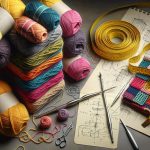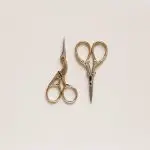Have you ever wondered why machines can’t crochet like humans? Crocheting is a unique and intricate art form that requires specific movements and techniques. While machines have come a long way in replicating human actions, crocheting remains an area where machines simply cannot compete with human hands.
To understand why machines can’t crochet, it’s important to first understand the basics of crocheting. Crocheting is a form of needlework that uses a hook to create intricate patterns and designs by interlocking loops of yarn. The movements required for crocheting involve a combination of hand-eye coordination, muscle memory, and creativity.
While machines can mimic some of these movements, it’s the human touch that brings the art of crocheting to life.
Table of Contents
Understanding the Basics of Crocheting
You can’t crochet if you don’t know the basics, but don’t worry, it’s easy to learn and you’ll be hooked in no time! Crocheting is a process of creating fabric by interlocking loops of yarn with a crochet hook. It’s a simple and enjoyable craft that can be used to make a wide range of items, from blankets and scarves to hats and bags.
To start crocheting, you’ll need a few basic tools, including a crochet hook and some yarn. The hook is used to pull the yarn through loops to create stitches, while the yarn forms the fabric. There are many different types of hooks and yarns available, so it’s important to choose the right ones for your project.
Once you have your tools, you can start learning the basic stitches. The most common stitches are the chain stitch, single crochet, and double crochet. These stitches are used to create different patterns and textures in the fabric.
With a little practice, you’ll be able to create a variety of beautiful and useful items using just a few simple stitches.
The Unique Movements Required for Crocheting
When you start to crochet, you’ll quickly realize that it requires some unique movements.
First, you’ll need to loop the yarn around the hook in a specific way to create each stitch.
Then, you’ll need to adjust the tension of the yarn by using the hook to pull it tighter or looser.
Finally, you’ll need to manipulate the yarn with your hands to create different textures and designs.
With practice, these movements will become second nature, and you’ll be able to create beautiful crocheted pieces with ease.
Looping Yarn with a Hook
By looping yarn with a hook, you can create intricate designs and patterns that add a unique touch to any project. Crocheting involves pulling the yarn through loops to create stitches that form a fabric. The hook is used to catch the yarn and pull it through the loops, making it possible to create a wide variety of patterns and textures.
To better understand the looping process, it can be helpful to visualize how the yarn moves through the hook and the loops. The table below outlines the basic steps involved in creating a single crochet stitch. By following these steps, you can begin to experiment with different yarns and hooks to create your own unique designs.
| Step | Description |
|---|---|
| 1 | Insert hook into stitch. |
| 2 | Yarn over hook. |
| 3 | Pull yarn through stitch. |
| 4 | Yarn over hook again. |
| 5 | Pull yarn through both loops on hook. |
| 6 | One single crochet stitch is complete. |
By mastering the looping process, you can create a wide range of crocheted items, from simple scarves to intricate doilies. While machines may be able to replicate some of the basic movements involved in crocheting, they cannot match the creativity and artistry that comes from the human touch. So next time you pick up your hook and yarn, remember that you are creating something truly unique and special.
Adjusting Tension with the Hook
Adjusting tension with the hook is a crucial skill for any crocheter looking to achieve a polished and professional finish to their projects. The tension of the yarn determines the size and shape of each stitch, and a consistent tension throughout the project ensures a uniform look.
Here are some tips for adjusting tension with the hook:
- Hold the hook comfortably but firmly, with your fingers wrapped around the handle and the hook resting in your palm.
- Use your non-dominant hand to hold the yarn, with the tail end between your index and middle fingers and the working end draped over your other fingers.
- Pull the yarn gently with your non-dominant hand as you make each stitch, but not so tight that it distorts the shape of the stitch.
- Practice adjusting your tension until it feels comfortable and natural, and be prepared to adjust it as needed for different types of yarn or projects.
With practice, adjusting tension becomes second nature and allows for a smooth and enjoyable crochet experience. Remember to take breaks and stretch your hands and fingers to prevent strain or injury, and enjoy the process of creating something beautiful with your own two hands.
Manipulating Yarn
To manipulate yarn successfully, you’ll need to become familiar with different techniques and textures. One of the most important things to keep in mind is the weight of the yarn. If you’re using a bulky yarn, you’ll need to adjust your hook size and tension accordingly.
On the other hand, if you’re working with a delicate lace weight yarn, you’ll need to handle it gently and use a smaller hook to avoid pulling and stretching the fibers.
Another important technique for manipulating yarn is controlling the twist. Most yarns are spun with a certain amount of twist, which can affect how the yarn behaves when you work with it.
If you’re finding that your yarn is twisting or kinking as you crochet, try letting it hang freely for a few moments to allow the twist to unwind. You can also try manipulating the yarn as you work, twisting it in the opposite direction to balance out the twist.
With some practice and experimentation, you’ll soon be able to manipulate yarn with ease and achieve the desired effect in your crochet projects.
The Limitations of Machine Technology
Unfortunately, machines just can’t crochet like a human can, no matter how advanced the technology gets. The limitations of machine technology are what prevent them from being able to create the intricate, delicate stitches that make crocheting such a beautiful art form.
Here are a few reasons why machines can’t quite measure up:
-
Machines lack the ability to feel the yarn and adjust their tension accordingly. Crocheting requires a lot of tactile feedback, as well as visual feedback, to create the perfect stitch. Machines simply can’t feel the yarn passing through their ‘fingers’ and make adjustments on the fly like a human can.
-
Machines are limited by their programming. Even the most advanced machines can only do what they’ve been programmed to do. They can’t improvise or come up with new stitch patterns on their own. This means that machine-made crocheted items will always lack the creativity and uniqueness that comes from human creativity.
-
Machines can’t replicate the human touch. When a person crochets, they’re infusing their work with a sense of themselves. Every stitch they make is imbued with their individual style and flair. Machines simply can’t replicate that sense of personality and humanity in their work.
While machines are incredibly useful for many tasks, they can never replace the artistry and creativity of human crocheters. So, next time you’re admiring a beautiful crocheted item, remember that it was likely made by hand, with love and care, by a skilled and talented person.
The Importance of the Human Touch
Nothing beats the personal touch that a human can bring to their crocheting, giving each item a unique charm and character. While machines are efficient and can produce items quickly, they lack the ability to add the same level of detail and care that a human can.
Every stitch made by a person is infused with their personality and creativity, making each item one-of-a-kind and special. The importance of the human touch in crocheting extends beyond just the aesthetic appeal of the final product.
When you crochet by hand, you are fully engaged in the process and can experience a sense of relaxation and mindfulness. The repetitive motion of crocheting can be meditative and calming, providing a therapeutic outlet for stress and anxiety. This mental and emotional connection to the craft is something that can’t be replicated by a machine.
Furthermore, the human touch in crocheting creates a sense of connection and community. When you receive a handmade crocheted item, you can feel the love and care that went into making it. It’s a tangible representation of the time and effort someone put into creating something just for you. This personal connection between the maker and the recipient is something that machines simply can’t replicate, and it’s what makes handmade crocheted items so special.
Examples of Handcrafted Crochet Pieces
Handcrafted crochet pieces showcase the unique creativity and personality of their makers, resulting in beautiful and one-of-a-kind items. These pieces are often made with intricate designs and attention to detail that machines simply can’t replicate.
Here are some examples of handcrafted crochet pieces that highlight the beauty and skill of the craft:
- Granny square blankets: These blankets are made up of small, colorful squares that are crocheted together to create a larger blanket. Each square can be made in a different color or pattern, allowing for endless possibilities and personalization.
- Amigurumi animals: These adorable stuffed animals are crocheted with small hooks and fine yarn to create intricate details and shapes. From cute cats to cuddly bears, amigurumi creations are perfect for children or as a unique gift for a loved one.
- Lace doilies: These delicate pieces are often made with fine thread and intricate patterns, requiring a high level of skill and patience. They can be used to decorate tables or framed as art pieces.
- Crochet clothing: From cozy sweaters to lightweight summer tops, crochet clothing can be made in a variety of styles to fit any occasion. Handcrafted pieces can feature unique color combinations or stitching patterns that add a personal touch to any outfit.
- Accessories: Hats, scarves, and gloves are just a few of the accessories that can be crocheted by hand. These pieces can be made with soft, warm yarns or with lightweight materials for a summery feel.
Handcrafted crochet pieces are unique and beautiful creations that highlight the creativity and skill of their makers. From blankets to clothing, these pieces can be made in a variety of styles and patterns to fit any occasion or personal taste.
So why settle for a machine-made item when you can have a one-of-a-kind piece that showcases your individuality?
The Future of Crochet and Technology
The evolution of technology has the potential to revolutionize the art of crochet, allowing for even greater precision and efficiency in the creation of intricate designs. With the rise of 3D printing and advanced robotics, it may not be long before machines are capable of replicating the intricate hand movements and techniques required for crochet. However, despite these advancements, it is unlikely that machines will ever fully replace the art of handcrafted crochet.
One reason for this is the emotional connection that many crocheters feel to their craft. Crochet is often seen as a meditative and therapeutic activity, and many people find joy in the physical act of manipulating yarn with their hands. Additionally, the imperfections and unique characteristics of handcrafted pieces are often seen as part of their charm and value. Machines may be able to create perfect, identical pieces, but they cannot replicate the personal touch and individuality of a handmade item.
Furthermore, there is a certain level of creativity and artistry that goes into handcrafted crochet pieces that cannot be replicated by a machine. While machines may be able to follow a set pattern or design, they cannot innovate or create new designs on their own. The creative process and artistic expression involved in crochet is an important part of the craft, and it is unlikely that machines will ever be able to fully replicate or replace that aspect.
| Pros | Cons | |||
|---|---|---|---|---|
| Greater precision | Lack of personal touch | |||
| Increased efficiency | Inability to innovate | |||
| Ability to replicate designs | Lack of emotional connection | |||
| Consistency in products | Limited creativity | Reduced human error | Dependence on technology |
Tips for Learning and Mastering Crochet
One way to improve your crochet skills is by watching video tutorials and practicing the techniques shown. There are countless online resources available, including YouTube channels, blogs, and websites. Look for tutorials that match your skill level and interests, and don’t be afraid to try something new.
As you practice, pay attention to your tension and stitch consistency, as these can greatly affect the appearance and quality of your finished projects.
Another helpful tip for learning and mastering crochet is to join a community or group of fellow crafters. This can be a local knitting or crochet group, an online forum, or a social media group. Being part of a community can provide support and encouragement, as well as opportunities to learn from others and share your own knowledge and experiences. You may even find inspiration for new projects or techniques to try.
Don’t be too hard on yourself if you make mistakes or struggle with a particular technique. Crochet, like any skill, takes time and practice to master. If you get frustrated or discouraged, take a break and come back to it later.
Remember that the process of learning and improving is just as important as the finished product, and enjoy the creativity and relaxation that crochet can bring to your life.
- Why Is Red Velvet Not Red? - April 25, 2024
- How Do You Describe Velvet Fabric? - April 25, 2024
- How Strong Is Velvet? - April 25, 2024





